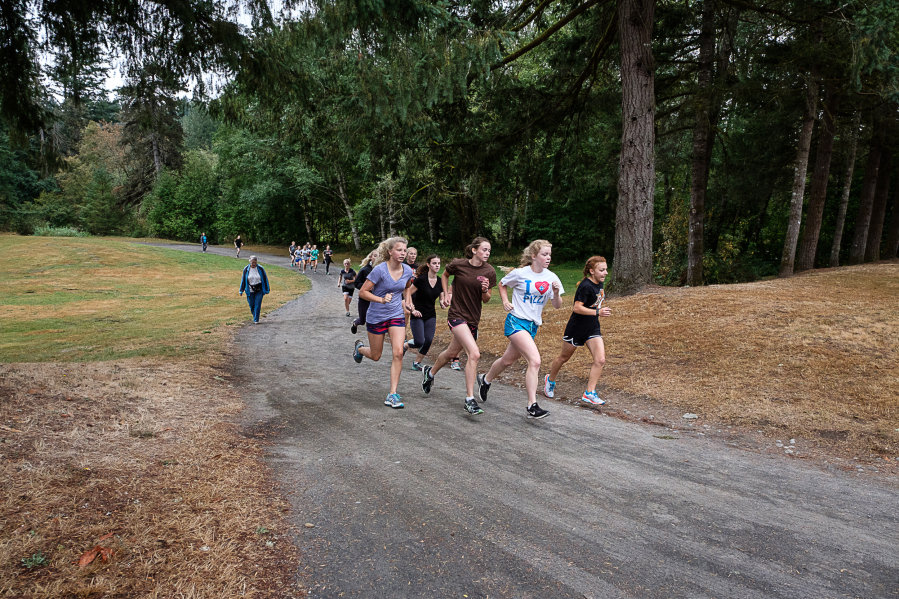Of the more than 1,000 rentable spaces in the county’s park system, more than two-thirds reserved last year were exclusive to Lewisville Park, the county’s oldest and most popular public park.
“Lewisville is by far our most busy park, and our most reserved park,” county Parks Division Manager Bill Bjerke said.
Check with the county’s website now, Bjerke said, and some of the park’s 13 shelter spaces have already been booked into next summer. In 2015, 665 reservations were made at the park, he said, and parks department staff expect more this year.
It’s also a versatile park, Bjerke said.
The 154-acre park north of Battle Ground has 17 barbecue grills, 147 picnic tables, 20 horseshoe pits, 15 sets of playground equipment, a boat launch, baseball and softball fields, spots for fishing and nearly 3 miles of trails.
Lewisville Park
• Where: 26411 N.E. Lewisville Highway, Battle Ground.
• Hours: 7 a.m. to dusk.
• Size: 154 acres of fields and forest along the East Fork of the Lewis River, ribboned by nearly 3 miles of trails.
• Amenities: In addition to the trails, open space, and swimming, 13 shelters — which seat 20 to 200 people — dot the park. They can be reserved for $25 to $100 per day depending on the shelter. All shelters have long tables, water spigots, power outlets and fire pits, and most have horseshoe pits and charcoal grills nearby. Reserve a space at apm.activecommunities.com/clarkcountyparks
• Parking: 307 spots, plus 23 disabled stalls.
• Swimming: At your own risk. There’s no lifeguard, and the East Fork of the Lewis River gets cold.
Lewisville Park hosts reunion parties, weddings, scouting trips and baptisms. Local high school cross country teams race and practice there.
“Being so well-established, everybody flocks to it, and it is the first park to be reserved for the entire year,” he said. “A lot of our customers have been going there for decades.”
The Lewis River, Lewis River Valley and the old settlement of Lewisville were named after the first settler on the river, Adolphus Lee Lewis, according to a history of Clark County from the secretary of state’s office.
Lewis was a county surveyor in 1856, and historians suspect he had some say in the change of the river’s name from the Native American name of Cathlapotle to Lewis River.
According to the county’s application to have the park added to the National Register of Historic Places, Lewisville was settled around 1873. What became Lewisville was first called Hall’s Crossing, then Hall’s Bridge.
The settlement sat near a ford on the East Fork of the Lewis River. Word is the crossing was very dangerous during the winter, prompting settlers to stock up on provisions in the fall. Hall’s Bridge — “a wooden structure, which crossed the river,” said the secretary of state’s office not-so-reassuringly — was swept away in 1883.
Three months later, the settlers built a new one with a cover to protect the planking. A sign on the bridge read “$10 fine for riding or driving across the bridge faster than a walk.”
The town was a growing community “with a store and a post office,” according to Columbian archives, before things went south.
In 1936, the county bought the town. Through 1940, workers from the Works Progress Administration, one of President Franklin Roosevelt’s Depression-alleviating New Deal programs, built the park. The park retained the old town’s name.
William Paeth, a former U.S. Forest Service employee, designed the park’s buildings, following the public land and building style pushed at the time by the National Park Service.
Workers built the park’s structures with peeled logs, lava rock, basalt, river rock and hand-split roof shakes, all “deliberately designed to be nonintrusive,” according to county records.
The only other local project that received WPA money was Leverich Park, but most of that money went to rebuilding the stadium now known as Kiggins Bowl.
By June 1937, WPA projects had put 800 workers to 12,350 man-months of work, according to the research included in the application for the national register. By the following summer, 16.5 percent of the county’s population was getting federal relief, most of it for work projects.
Federal expenditures on the project, namely from grants through the WPA, came to about $102,000, close to 80 percent of the total. That’s roughly $1.8 million in today’s dollars. Much of the county’s contribution came from raw materials.
Amenities have changes since, but workers during the first four-year building span landscaped 95 acres, added 16 fireplaces and 128 picnic tables, laid 2,567 square yards of road, built 122 feet of bridges and made 1,160 feet of paths.
“Nowhere but in Lewisville Park are there Depression-era resources of the same quality, workmanship and distinct style,” wrote a petitioner in the park’s national register nomination.
Lewisville Park was added to the register in 1986 and named to the Clark County Heritage Register in 1987.
Bjerke said the county hopes to expand the park, though those plans are all very abstract.
Phase 2 of Lewisville Park would go west of Highway 503, and the tentative plan would have the county buying 500 acres of space in chunks, likely in the Lewis River Ranch property nearby, he said.
Amenities might include playing fields and additional shelters.
“There’s been a large outcry for disc golf courses, also mountain biking courses,” he said.
Adding to the park would probably include building on to the county’s regional trails plan, Bjerke said.
The county’s plans would connect the parks on the East Fork of the Lewis River with a shared-use trail running Paradise Point State Park to Lewisville Park, Daybreak Park and on to Moulton Falls.
Expanding trails or adding onto the park are all contingent on grants and funding opportunities, he said, and any such changes are likely a decade out.




